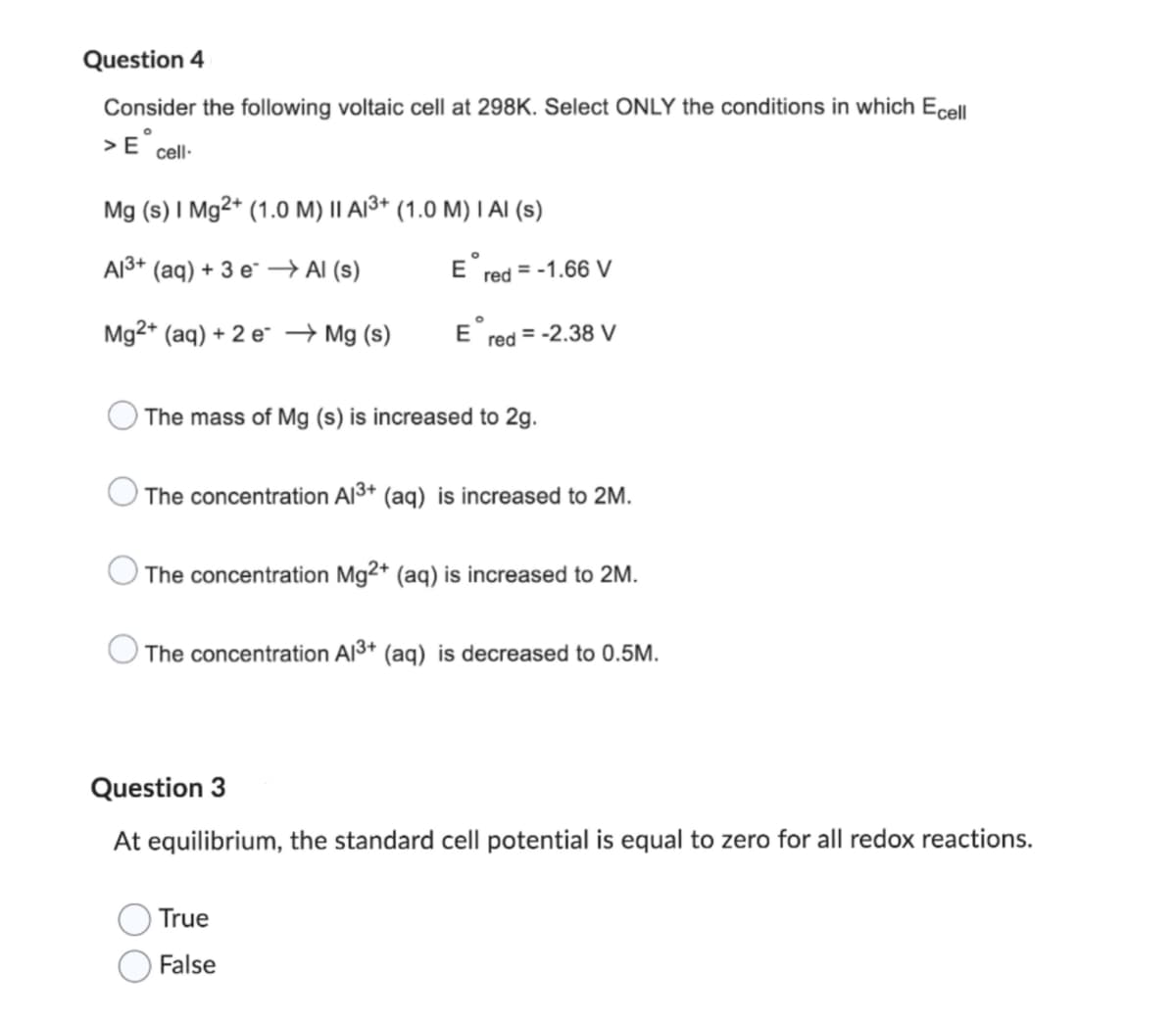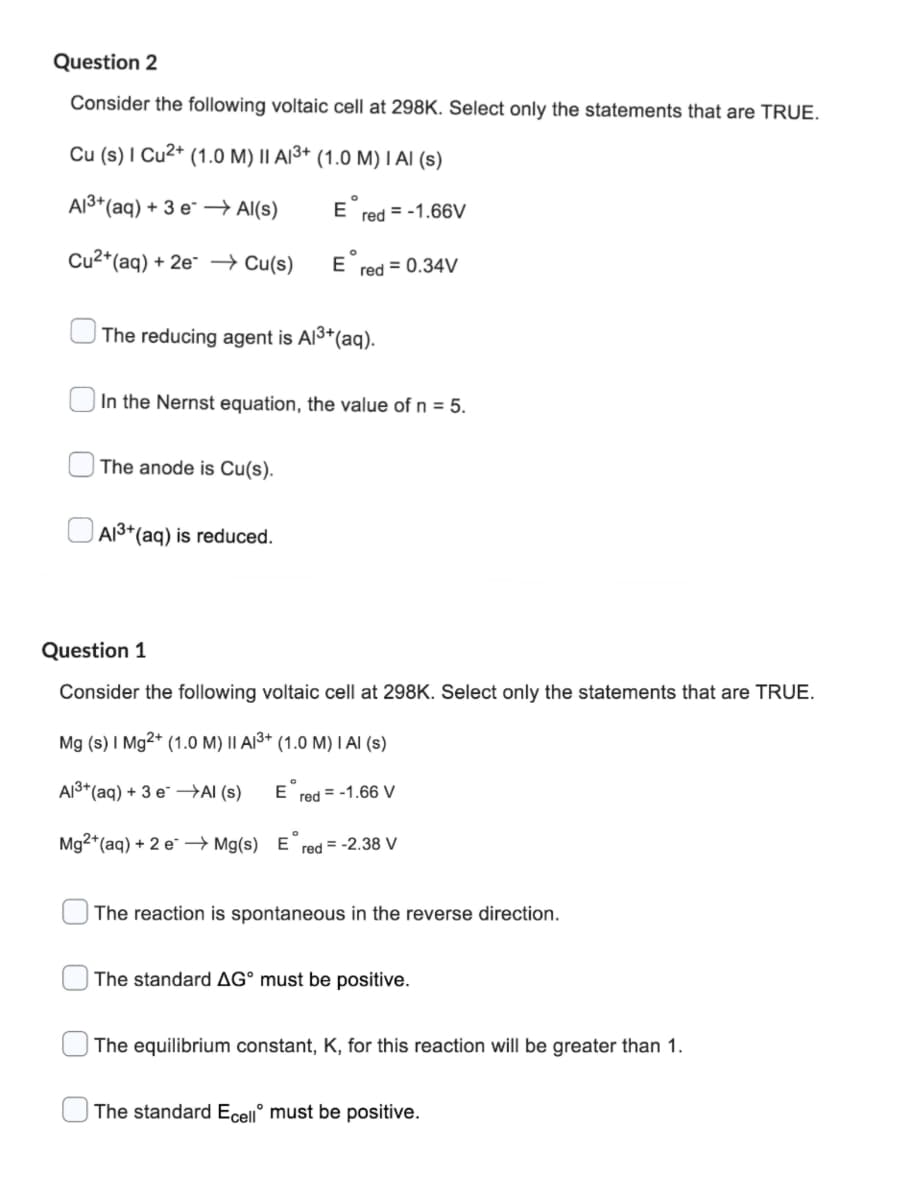Question 2 Consider the following voltaic cell at 298K. Select only the statements that are TRUE. Cu (s) I Cu2+ (1.0 M) II A1³+ (1.0 M) I AI (s) Al³+ (aq) + 3 e →→ Al(s) Ered=-1.66V Cu2+ (aq) + 2e →→ Cu(s) Ered = 0.34V The reducing agent is Al³+ (aq). In the Nernst equation, the value of n = 5. The anode is Cu(s). Al³+ (aq) is reduced. Question 1 Consider the following voltaic cell at 298K. Select only the statements that are TRUE. Mg (s) 1 Mg2+ (1.0 M) II A13+ (1.0 M) I Al (s) Al3+ (aq) + 3 e →→Al(s) Ered = -1.66 V Mg2+ (aq) + 2 e→→Mg(s) Ered = -2.38 V The reaction is spontaneous in the reverse direction. The standard AG° must be positive. The equilibrium constant, K, for this reaction will be greater than 1. The standard Ecell must be positive.
Question 2 Consider the following voltaic cell at 298K. Select only the statements that are TRUE. Cu (s) I Cu2+ (1.0 M) II A1³+ (1.0 M) I AI (s) Al³+ (aq) + 3 e →→ Al(s) Ered=-1.66V Cu2+ (aq) + 2e →→ Cu(s) Ered = 0.34V The reducing agent is Al³+ (aq). In the Nernst equation, the value of n = 5. The anode is Cu(s). Al³+ (aq) is reduced. Question 1 Consider the following voltaic cell at 298K. Select only the statements that are TRUE. Mg (s) 1 Mg2+ (1.0 M) II A13+ (1.0 M) I Al (s) Al3+ (aq) + 3 e →→Al(s) Ered = -1.66 V Mg2+ (aq) + 2 e→→Mg(s) Ered = -2.38 V The reaction is spontaneous in the reverse direction. The standard AG° must be positive. The equilibrium constant, K, for this reaction will be greater than 1. The standard Ecell must be positive.
Chemistry: Principles and Reactions
8th Edition
ISBN:9781305079373
Author:William L. Masterton, Cecile N. Hurley
Publisher:William L. Masterton, Cecile N. Hurley
Chapter17: Electrochemistry
Section: Chapter Questions
Problem 105QAP: Consider a voltaic cell in which the following reaction occurs. Zn(s)+Sn2+(aq)Zn2+(aq)+Sn(s) (a)...
Related questions
Question
please help me with these four questions. i will really appreciated it

Transcribed Image Text:Question 4
Consider the following voltaic cell at 298K. Select ONLY the conditions in which Ecell
O
> E° cell.
Mg (s) | Mg2+ (1.0 M) II A1³+ (1.0 M) I Al (s)
Al³+ (aq) + 3 e →→ Al (s)
Mg2+ (aq) + 2 e → Mg (s)
Ered = -1.66V
Ered = -2.38 V
The mass of Mg (s) is increased to 2g.
The concentration Al³+ (aq) is increased to 2M.
The concentration Mg2+ (aq) is increased to 2M.
The concentration Al³+ (aq) is decreased to 0.5M.
Question 3
At equilibrium, the standard cell potential is equal to zero for all redox reactions.
True
False

Transcribed Image Text:Question 2
Consider the following voltaic cell at 298K. Select only the statements that are TRUE.
Cu (s) I Cu²+ (1.0 M) II A1³+ (1.0 M) I AI (s)
Al³+ (aq) + 3 e →→ Al(s)
E red=-1.66V
Cu2+ (aq) + 2e →→ Cu(s)
Ered = 0.34V
The reducing agent is Al³+ (aq).
In the Nernst equation, the value of n = 5.
The anode is Cu(s).
Al³+ (aq) is reduced.
Question 1
Consider the following voltaic cell at 298K. Select only the statements that are TRUE.
Mg (s) 1 Mg2+ (1.0 M) II A13+ (1.0 M) I Al (s)
Al³+ (aq) + 3 e →→Al(s)
Ered = -1.66 V
Mg2+ (aq) + 2 e →→ Mg(s) Ered= -2.38 V
The reaction is spontaneous in the reverse direction.
The standard AG° must be positive.
The equilibrium constant, K, for this reaction will be greater than 1.
The standard Ecell must be positive.
Expert Solution
This question has been solved!
Explore an expertly crafted, step-by-step solution for a thorough understanding of key concepts.
Step by step
Solved in 6 steps with 5 images

Knowledge Booster
Learn more about
Need a deep-dive on the concept behind this application? Look no further. Learn more about this topic, chemistry and related others by exploring similar questions and additional content below.Recommended textbooks for you

Chemistry: Principles and Reactions
Chemistry
ISBN:
9781305079373
Author:
William L. Masterton, Cecile N. Hurley
Publisher:
Cengage Learning

Chemistry for Engineering Students
Chemistry
ISBN:
9781337398909
Author:
Lawrence S. Brown, Tom Holme
Publisher:
Cengage Learning

Chemistry: Principles and Practice
Chemistry
ISBN:
9780534420123
Author:
Daniel L. Reger, Scott R. Goode, David W. Ball, Edward Mercer
Publisher:
Cengage Learning

Chemistry: Principles and Reactions
Chemistry
ISBN:
9781305079373
Author:
William L. Masterton, Cecile N. Hurley
Publisher:
Cengage Learning

Chemistry for Engineering Students
Chemistry
ISBN:
9781337398909
Author:
Lawrence S. Brown, Tom Holme
Publisher:
Cengage Learning

Chemistry: Principles and Practice
Chemistry
ISBN:
9780534420123
Author:
Daniel L. Reger, Scott R. Goode, David W. Ball, Edward Mercer
Publisher:
Cengage Learning

Chemistry: The Molecular Science
Chemistry
ISBN:
9781285199047
Author:
John W. Moore, Conrad L. Stanitski
Publisher:
Cengage Learning


Chemistry: An Atoms First Approach
Chemistry
ISBN:
9781305079243
Author:
Steven S. Zumdahl, Susan A. Zumdahl
Publisher:
Cengage Learning